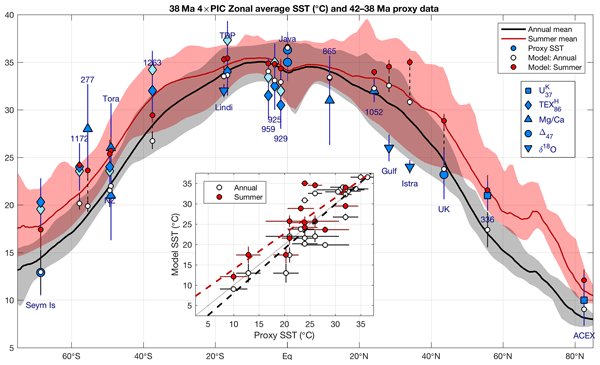I’ll preface that I wouldn’t want to live in the Eocene – it was the warmest phase of the Neogene (the geological period encompassing the Tertiary and Quaternary), the Earth was then practically all covered with tropical forest and the habitats where the genus Homo is at home and thrives best – savannahs – were almost non-existent. Nor were there proper animals made for grazing grasses and converting them into steaks and burgers, typically large tours. And the sea level was quite a bit higher, not a great time for Londoners, Dutchmen and seaside resort owners.The fact is that the “average temperature of the Earth” then was 27 deg. Today it’s about 15 degrees Celsius. C. So not the 2-4 degree rise that the climatologists are dreading, but 12 degrees.
But the chart below is more interesting. It shows how Eocene temperatures were distributed on Earth. At the 50th parallel, which is Prague, it averaged about 25 degrees. Celsius – which corresponds to northern India. At the 70th degree, which is St. Petersburg, the climate would have been roughly like Mexico City, and only at the 80th degree, which is northern Greenland, would it have been like Prague today. But look at the hot tropics. They’re still tropics (average annual something above 30 degrees, which is what Manaus, Brazil has). No “we’ll burn” or “climate migration will occur”. Nothing has changed there. That’s also why tropical forests are sometimes referred to as “the oldest ecosystems on Earth”, why fossils of tropical plants from that era are indistinguishable from tropical plants today, and why if you carved a rainforest plant somewhere in the Congo of that time and transplanted it to the Congo of today, the plant would recognize nothing.
It’s not surprising, all climate changes ( = onset and end of ice ages, etc.) are always sharpest around the 50th parallel, i.e. in the temperate zone, i.e. here. Actually, this explains the occasional hysterical cries of journalists that the Czech Republic (Poland, Slovakia, southern Russia…) is warming X times faster than the rest of the planet. It can’t be any other way, it always warms (and cools) the fastest here.That’s why it’s simply true that with all the “climate change” (by 2-3 degrees…) probably nothing will happen on most of the Earth.
(Martin Konvička is a professor of biology)


